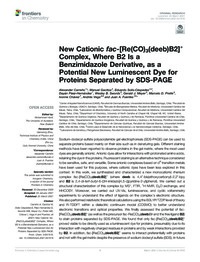Mostrar el registro sencillo de la publicación
New cationic fac-[Re(CO)3(deeb)B2]+ complex, where B2 is a benzimidazole derivative, as a potential new luminescent dye for proteins separated by SDS-PAGE
| dc.contributor.author | Carreño, Alexander | |
| dc.contributor.author | Gacitúa, Manuel | |
| dc.contributor.author | Solis-Céspedes, Eduardo | |
| dc.contributor.author | Páez-Hernández, Dayán | |
| dc.contributor.author | Swords, Wesley B. | |
| dc.contributor.author | Meyer, Gerald J. | |
| dc.contributor.author | Preite, Marcelo D. | |
| dc.contributor.author | Chávez, Ivonne | |
| dc.contributor.author | Vega, Andrés | |
| dc.contributor.author | Fuentes, Juan A. | |
| dc.date.accessioned | 2021-12-14T12:22:20Z | |
| dc.date.available | 2021-12-14T12:22:20Z | |
| dc.date.issued | 2021 | |
| dc.identifier.uri | http://repositorio.ucm.cl/handle/ucm/3572 | |
| dc.description.abstract | Sodium-dodecyl-sulfate polyacrylamide gel electrophoresis (SDS-PAGE) can be used to separate proteins based mainly on their size such as in denaturing gels. Different staining methods have been reported to observe proteins in the gel matrix, where the most used dyes are generally anionic. Anionic dyes allow for interactions with protonated amino acids, retaining the dye in the proteins. Fluorescent staining is an alternative technique considered to be sensitive, safe, and versatile. Some anionic complexes based on d6 transition metals have been used for this purpose, where cationic dyes have been less explored in this context. In this work, we synthesized and characterized a new monocationic rhenium complex fac-[Re(CO)3(deeb)B2]+ (where deeb is 4,4′-bis(ethoxycarbonyl)-2,2′-bpy and B2 is 2,4-di-tert-butyl-6-(3H-imidazo[4,5-c]pyridine-2-yl)phenol). We carried out a structural characterization of this complex by MS+, FTIR, 1H NMR, D2O exchange, and HHCOSY. Moreover, we carried out UV-Vis, luminescence, and cyclic voltammetry experiments to understand the effect of ligands on the complex’s electronic structure. We also performed relativistic theoretical calculations using the B3LYP/TZ2P level of theory and R-TDDFT within a dielectric continuum model (COSMO) to better understand electronic transitions and optical properties. We finally assessed the potential of fac-[Re(CO)3(deeb)B2]+ (as well as the precursor fac-Re(CO)3(deeb)Br and the free ligand B2) to stain proteins separated by SDS-PAGE. We found that only fac-[Re(CO)3(deeb)B2]+ proved viable to be directly used as a luminescent dye for proteins, presumably due to its interaction with negatively charged residues in proteins and by weak interactions provided by B2. In addition, fac-[Re(CO)3(deeb)B2]+ seems to interact preferentially with proteins and not with the gel matrix despite the presence of sodium dodecyl sulfate (SDS). In future applications, these alternative cationic complexes might be used alone or in combination with more traditional anionic compounds to generate counterion dye stains to improve the process. | es_CL |
| dc.language.iso | en | es_CL |
| dc.rights | Atribución-NoComercial-SinDerivadas 3.0 Chile | * |
| dc.rights.uri | http://creativecommons.org/licenses/by-nc-nd/3.0/cl/ | * |
| dc.source | Frontiers in Chemistry, 9, 647816 | es_CL |
| dc.subject | Rhenium(I) tricarbonyl | es_CL |
| dc.subject | Cyclic voltammetry | es_CL |
| dc.subject | Relativistic DFT | es_CL |
| dc.subject | Protein dye | es_CL |
| dc.subject | SDS-PAGE | es_CL |
| dc.subject | Protein | es_CL |
| dc.title | New cationic fac-[Re(CO)3(deeb)B2]+ complex, where B2 is a benzimidazole derivative, as a potential new luminescent dye for proteins separated by SDS-PAGE | es_CL |
| dc.type | Article | es_CL |
| dc.ucm.facultad | Facultad de Medicina | es_CL |
| dc.ucm.indexacion | Scopus | es_CL |
| dc.ucm.indexacion | Isi | es_CL |
| dc.ucm.uri | www.frontiersin.org/articles/10.3389/fchem.2021.647816/full | es_CL |
| dc.ucm.doi | doi.org/10.3389/fchem.2021.647816 | es_CL |



